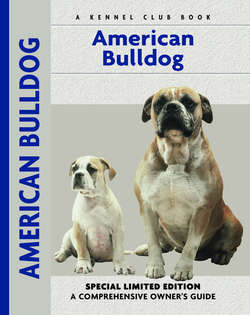Читать книгу American Bulldog - Abe Fishman - Страница 14
На сайте Литреса книга снята с продажи.
UKC STANDARD FOR THE AMERICAN BULLDOG HISTORY
ОглавлениеBulldogs in England were originally working dogs who drove and caught cattle and guarded their masters’ property. The breed’s strength, courage and familiarity with livestock led to its popularity in the brutal sport of bullbaiting. When this sport was outlawed in England, the original type of Bulldog disappeared from Britain and was replaced with the shorter, stockier, less athletic dog we now know as the English Bulldog.
An impressive head on a Dutch-bred American Bulldog.
The original Bulldog, however, was preserved by working class immigrants who brought their working dogs with them to the American South. Small farmers and ranchers used this all-around working dog for many tasks. By the end of World War II, however, the breed was almost extinct. Mr. John D. Johnson, a returning war veteran, decided to resurrect this breed. Along with Alan Scott and several other breeders, Johnson began carefully to breed American Bulldogs, keeping careful records and always with an eye for maintaining the breed’s health and working abilities.
Because of the many different types of work this breed can do, several distinct lines evolved, each emphasizing the traits needed to do a specific job. The best known lines are usually referred to as the Johnson and Scott types. The Johnson dogs are more massive, with a larger, broader head and shorter muzzle, and a definite undershot bite. The Scott dogs were somewhat lighter in musculature and bone than the Johnson dogs, with a less Mastiff-like head. Today, however, most American Bulldogs have crosses to two or more of these lines and are not as easily distinguishable.
The modern American Bulldog continues to serve as an all-purpose working dog; a fearless and steady guard dog; and a loyal family companion.
The American Bulldog was recognized by the United Kennel Club on January 1, 1999.
